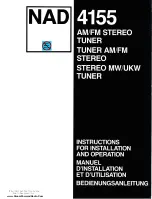
AR8000 operating manual
113
If the transmitted frequency is too high for to be reflected by the ionosphere,
or the angle too steep, transmissions will simply pass straight though the
ionosphere without being reflected and will travel upward to the next
ionosphere layer.
“E” layer
Above the “D” layer is the “E” layer located at a height of about 100 kilometres.
The “E” layer tends not to absorb signals as much as the “D” layer but refracts
some signal back to Earth where it may be received some distance from the
original point of transmission.
Usually in Autumn and Spring “SPORADIC E” propagation consisting of dense
pockets of “E” layer ionosphere, reflect even the higher VHF and UHF
transmissions causing patterning on television sets. This is to the delight of
Radio Amateurs who are then able to communicate for many hundreds and
even thousands of kilometres on frequency bands usually capable of only local
reception.
Occasionally a similar effect can be caused by temperature inversion layers
creating “tropospheric propagation” selectively “ducting” transmissions
between two points. Tropospheric propagation is usually applicable to the
higher VHF and UHF bands.
“F1” & “F2” layers
During the day time there are two upper layers of the ionosphere, these
being the “F1” layer at about 200 kilometres and the “F2” layer at about 400
kilometres. As evening falls, these layers combine to form a single “F” layer.
It is “F” layer propagation that is largely responsible for shortwave propagation
over great distances.
The density of the ionosphere layers varies depending upon season, time of
day and sunspot activity which is believed to follow an eleven year cycle of
good and bad propagation conditions.
Содержание AR8000
Страница 15: ...AR8000 operating manual 15...
Страница 25: ...AR8000 operating manual 25...
Страница 29: ...AR8000 operating manual 29...



































